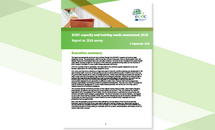Enhanced surveillance of severe avian influenza virus infections in hospital settings in the EU/EEA
This document describes how to strengthen surveillance in hospital settings for the identification of severely affected patients infected with avian influenza virus in the EU/EEA.
Executive summary
Avian influenza virus outbreaks are continuing during the summer months, causing mass mortality in sea-breeding bird colonies, including gulls. A larger exposure of human population to sick or dead birds and mammals is expected to occur.
Transmission to humans cannot be excluded when avian influenza is circulating in wild birds and mammals and people are directly exposed without wearing protective equipment. During the summer months, infections with seasonal influenza viruses are considered to be very limited, and only a few patients with severe disease caused by the seasonal influenza virus are expected to be admitted to hospitals.
To identify sporadic severe human infections with avian influenza virus in hospital settings, the following approach is proposed:
- People admitted to hospitals with respiratory symptoms should be asked about exposure to birds (wild birds or poultry) or other wild animals (dead or alive) in the two weeks before admission.
- Consider testing for influenza virus hospitalised patients with unexplained viral encephalitis/ meningoencephalitis lacking the aetiological agent diagnosis.
- All influenza A-positive samples from hospitalised patients should be subtyped for seasonal influenza viruses A(H1)pdm09 and A(H3).
- Samples positive for influenza type A virus but negative for A(H1)pdm09 or A(H3) should be immediately sent to national influenza reference laboratories for further analysis and H5 testing.








